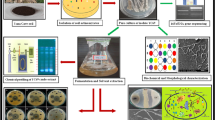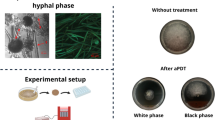Abstract
An increasing concern on resistance to multiple-antibiotics has led to the discovery of novel agents and the establishment of new precaution strategy. Numerous plant sources have been widely studied to reduce virulence of pathogenic bacteria by interfering cell-to-cell based communication called quorum sensing (QS). Leaf extracts of 17 gardening trees were collected and investigated for their anti-QS effects using a sensor strain Chromobacterium violaceum CV026. Methanolic extracts of K4 (Acer palmatum), K9 (Acer pseudosieboldianum) and K13 (Cercis chinensis) leaves were selected for further experiments based on their antagonism effect on QS without inhibiting C. violaceum CV026 growth. Subsequently, the leaf extracts on QS-mediated virulence of Pseudomonas aeruginosa PAO1 involved in biofilm formation, motility, bioluminescence, pyocyanin production, QS molecules production, and Caenorhabditis elegans killing activity were evaluated. The biofilm formation ability and swarming motility of P. aeruginosa PAO1 were decreased approximately 50% in the presence of these leaf extracts at a concentration of 1 mg/mL. The expression level of lecA::lux of P. aeruginosa PAO1 and pyocyanin production were also reduced. The three leaf extracts also decreased autoinducer (AI) production in P. aeruginosa PAO1 without direct degradation, suggesting that AI synthesis might have been suppressed by these extracts. The three leaf extracts also showed anti-infection activity in C. elegans model. Taken together, these results suggest that methanolic leaf extracts of K4, K9 and K13 have the potential to attenuate the virulence of P. aeruginosa PAO1.







Similar content being viewed by others
References
Neu HC (1992) The crisis in antibiotic resistance. Science 257:1064–1073. doi:10.1126/science.257.5073.1064
Queck SY, Jameson-Lee M, Villaruz AE, Bach TH, Khan BA, Sturdevant DE, Ricklefs SM, Li M, Otto M (2008) RNAIII-independent target gene control by the agr quorum-sensing system: insight into the evolution of virulence regulation in Staphylococcus aureus. Mol Cell 32:150–158. doi:10.1016/j.molcel.2008.08.005
Boles BR, Horswill AR (2008) Agr-mediated dispersal of Staphylococcus aureus biofilms. PLoS Pathog 4:e1000052. doi:10.1371/journal.ppat.1000052
Park J, Jagasia R, Kaufmann GF, Mathison JC, Ruiz DI, Moss JA, Meijler MM, Ulevitch RJ, Janda KD (2007) Infection control by antibody disruption of bacterial quorum sensing signaling. Chem Biol 14:1119–1127. doi:10.1016/j.chembiol.2007.08.013
Frenzel E, Doll V, Pauthner M, Lucking G, Scherer S, Ehling-Schulz M (2012) CodY orchestrates the expression of virulence determinants in emetic Bacillus cereus by impacting key regulatory circuits. Mol Microbiol 85:67–88. doi:10.1111/j.1365-2958.2012.08090.x
Mattmann ME, Blackwell HE (2010) Small molecules that modulate quorum sensing and control virulence in Pseudomonas aeruginosa. J Org Chem 75:6737–6746. doi:10.1021/jo101237e
Liu HB, Lee JH, Kim JS, Park S (2010) Inhibitors of the Pseudomonas aeruginosa quorum-sensing regulator, QscR. Biotechnol Bioeng 106:119–126. doi:10.1002/bit.22672
Brackman G, Celen S, Baruah K, Bossier P, Van Calenbergh S, Nelis HJ, Coenye T (2009) AI-2 quorum-sensing inhibitors affect the starvation response and reduce virulence in several Vibrio species, most likely by interfering with LuxPQ. Microbiology 155:4114–4122. doi:10.1099/mic.0.032474-0
Ng WL, Perez L, Cong J, Semmelhack MF, Bassler BL (2012) Broad spectrum pro-quorum-sensing molecules as inhibitors of virulence in vibrios. PLoS Pathog 8:e1002767. doi:10.1371/journal.ppat.1002767
Miller MB, Bassler BL (2001) Quorum sensing in bacteria. Annu Rev Microbiol 55:165–199. doi:10.1146/annurev.micro.55.1.165
Tsai CS, Winans SC (2010) LuxR-type quorum-sensing regulators that are detached from common scents. Mol Microbiol 77:1072–1082. doi:10.1111/j.1365-2958.2010.07279.x
Rutherford ST, Bassler BL (2012) Bacterial quorum sensing: its role in virulence and possibilities for its control. Cold Spring Harbor Perspect Med 2:11. doi:10.1101/cshperspect.a012427
Passador L, Cook JM, Gambello MJ, Rust L, Iglewski BH (1993) Expression of Pseudomonas aeruginosa virulence genes requires cell-to-cell communication. Science 260:1127–1130. doi:10.1126/science.8493556
Brint JM, Ohman DE (1995) Synthesis of multiple exoproducts in Pseudomonas aeruginosa is under the control of RhlR–RhlI, another set of regulators in strain PAO1 with homology to the autoinducer-responsive LuxR–LuxI family. J Bacteriol 177:7155–7163. doi:10.1128/jb.177.24.7155-7163.1995
McClean KH, Winson MK, Fish L, Taylor A, Chhabra SR, Camara M, Daykin M, Lamb JH, Swift S, Bycroft BW (1997) Quorum sensing and Chromobacterium violaceum: exploitation of violacein production and inhibition for the detection of N-acylhomoserine lactones. Microbiology 143:3703–3711. doi:10.1099/00221287-143-12-3703
Hurley MN, Camara M, Smyth AR (2012) Novel approaches to the treatment of Pseudomonas aeruginosa infections in cystic fibrosis. Eur Respir J 40:1014–1023. doi:10.1183/09031936.00042012
Wagner S, Sommer R, Hinsberger S, Lu C, Hartmann RW, Empting M, Titz A (2016) Novel strategies for the treatment of Pseudomonas aeruginosa infections. J Med Chem 59:5929–5969. doi:10.1021/acs.jmedchem.5b01698
Hauber HP, Schulz M, Pforte A, Mack D, Zabel P, Schumacher U (2008) Inhalation with fucose and galactose for treatment of Pseudomonas aeruginosa in cystic fibrosis patients. Int J Med Sci 5:371–376. doi:10.7150/ijms.5.371
Moreau-Marquis S, O’Toole GA, Stanton BA (2009) Tobramycin and FDA-approved iron chelators eliminate Pseudomonas aeruginosa biofilms on cystic fibrosis cells. Am J Respir Cell Mol Biol 41:305–313. doi:10.1165/rcmb.2008-0299OC
Kaneko Y, Thoendel M, Olakanmi O, Britigan BE, Singh PK (2007) The transition metal gallium disrupts Pseudomonas aeruginosa iron metabolism and has antimicrobial and antibiofilm activity. J Clin Investig 117:877–888. doi:10.1172/JCI30783
Coban AY, Ekinci B, Durupinar B (2004) A multidrug efflux pump inhibitor reduces fluoroquinolone resistance in Pseudomonas aeruginosa isolates. Chemotherapy 50:22–26. doi:10.1159/000077280
Tan XX, Actor JK, Chen Y (2005) Peptide nucleic acid antisense oligomer as a therapeutic strategy against bacterial infection: proof of principle using mouse intraperitoneal infection. Antimicrob Agents Chemother 49:3203–3207. doi:10.1128/AAC.49.8.3203-3207.2005
Hagens S, Habel A, von Ahsen U, von Gabain A, Blasi U (2004) Therapy of experimental Pseudomonas infections with a nonreplicating genetically modified phage. Antimicrob Agents Chemother 48:3817–3822. doi:10.1128/AAC.48.10.3817-3822.2004
Borges A, Abreu AC, Dias C, Saavedra MJ, Borges F, Simões M (2016) New perspectives on the use of phytochemicals as an emergent strategy to control bacterial infections including biofilms. Molecules 21:877. doi:10.3390/molecules21070877
Nazzaro F, Fratianni F, Coppola R (2013) Quorum sensing and phytochemicals. Int J Mol Sci 14:12607–12619. doi:10.3390/ijms140612607
LaSarre B, Federle MJ (2013) Exploiting quorum sensing to confuse bacterial pathogens. Microbiol Mol Biol Rev 77:73–111. doi:10.1128/MMBR.00046-12
Koh CL, Sam CK, Yin WF, Tan LY, Krishnan T, Chong YM, Chan KG (2013) Plant-derived natural products as sources of anti-quorum sensing compounds. Sensors 13:6217–6228. doi:10.3390/s130506217
Chen JW, Chen YH, Lin FY, Chen YL, Lin SJ (2003) Ginkgo biloba extract inhibits tumor necrosis factor-alpha-induced reactive oxygen species generation, transcription factor activation, and cell adhesion molecule expression in human aortic endothelial cells. Arterioscler Thromb Vasc Biol 23:1559–1566. doi:10.1161/01.ATV.0000089012.73180.63
Na M, Min BS, Bae K (2009) Antioxidant compounds from Cersis chinensis Bunge. Bull Korean Chem Soc 30:2765–2768. doi:10.5012/bkcs.2009.30.11.2765
Maisuria VB, Hosseinidoust Z, Tufenkji N (2015) Polyphenolic extract from maple syrup potentiates antibiotic susceptibility and reduces biofilm formation of pathogenic bacteria. Appl Environ Microbiol 81:3782–3792. doi:10.1128/AEM.00239-15
Hayouni EA, Bouix M, Abedrabba M, Leveau JY, Hamdi M (2008) Mechanism of action of melaleuca armillaris (Sol. Ex Gaertu) Sm. essential oil on six LAB strains as assessed by multiparametric flow cytometry and automated microtiter-based assay. Food Chem 111:707–718. doi:10.1016/j.foodchem.2008.04.044
Tan LY, Yin WF, Chan KG (2012) Silencing quorum sensing through extracts of Melicope lunu-ankenda. Sensors 12:4339–4351. doi:10.3390/s120404339
Djordjevic D, Wiedmann M, McLandsborough LA (2002) Microtiter plate assay for assessment of Listeria monocytogenes biofilm formation. App Environ Microbiol 68:2950–2958. doi:10.1128/aem.68.6.2950-2958.2002
Priya K, Yin WF, Chan KG (2013) Anti-quorum sensing activity of the traditional Chinese herb, Phyllanthus amarus. Sensors 13:14558–14569. doi:10.3390/s131114558
Krishnan T, Yin WF, Chan KG (2012) Inhibition of quorum sensing-controlled virulence factor production in Pseudomonas aeruginosa PAO1 by Ayurveda spice clove (Syzygium aromaticum) bud extract. Sensors 12:4016–4030. doi:10.3390/s120404016
Winzer K, Falconer C, Garber NC, Diggle SP, Camara M, Williams P (2000) The Pseudomonas aeruginosa lectins PA-IL and PA-IIL are controlled by quorum sensing and by RpoS. J Bacteriol 182:6401–6411. doi:10.1128/JB.182.22.6401-6411.2000
Brenner S (1974) The genetics of Caenorhabditis elegans. Genetics 77: 71–94. https://www.ncbi.nlm.nih.gov/pmc/articles/PMC1213120/
Tan MW, Rahme LG, Sternberg JA, Tompkins RG (1999) Ausubel, F.M. Pseudomonas aeruginosa killing of Caenorhabditis elegans used to identify P. aeruginosa virulence factors. Proc Natl Acad Sci 96:2408–2413. doi:10.1073/pnas.96.5.2408
Oliveira BDÁ, Rodrigues AC, Cardoso BMI, Ramos ALCC, Bertoldi MC, Taylor JG, da Cunha LR, Pinto UM (2016) Antioxidant, antimicrobial and anti-quorum sensing activities of Rubus rosaefolius phenolic extract. Ind Crops Prod 84:59–66. doi:10.1016/j.indcrop.2016.01.037
Rodrigues AC, Zola FG, Ávila Oliveira BD, Sacramento NTB, da Silva ER, Bertoldi MC, Taylor JG, Pinto UM (2016) Quorum quenching and microbial control through phenolic extract of Eugenia uniflora fruits. J Food Sci. doi:10.1111/1750-3841.13431
Lebeaux D, Ghigo JM, Beloin C (2014) Biofilm-related infections: bridging the gap between clinical management and fundamental aspects of recalcitrance toward antibiotics. Microbiol Mol Biol Rev 78:510–543. doi:10.1128/MMBR.00013-14
Fazli M, Almblad H, Rybtke ML, Givskov M, Eberl L, Tolker-Nielsen T (2014) Regulation of biofilm formation in Pseudomonas and Burkholderia species. Environ Microbiol 16:1961–1981. doi:10.1111/1462-2920.12448
Chang CY, Krishnan T, Wang H, Chen Y, Yin WF, Chong YM, Tan LY, Chong TM, Chan KG (2014) Non-antibiotic quorum sensing inhibitors acting against N-acyl homoserine lactone synthase as druggable target. Sci Rep 4:7245. doi:10.1038/srep07245
Kim G, Oh I, Wang W, Kim I (1995) Phenolic compounds from Cercis chinensis leaves. Pharm Soc Korea 39:600–609
Lee JH, Park JH, Cho HS, Joo SW, Cho MH, Lee J (2013) Anti-biofilm activities of quercetin and tannic acid against Staphylococcus aureus. Biofouling 29:491–499. doi:10.1080/08927014.2013.788692
Lee JH, Cho HS, Joo SW, Chandra Regmi S, Kim JA, Ryu CM, Ryu SY, Cho MH, Lee J (2013) Diverse plant extracts and trans-resveratrol inhibit biofilm formation and swarming of Escherichia coli O157: H7. Biofouling 29:1189–1203. doi:10.1080/08927014.2013.832223
Chemani C, Imberty A, de Bentzmann S, Pierre M, Wimmerová M, Guery BP, Faure K (2009) Role of LecA and LecB lectins in Pseudomonas aeruginosa-induced lung injury and effect of carbohydrate ligands. Infect Immun 77:2065–2075. doi:10.1128/IAI.01204-08
Defoirdt T, Brackman G, Coenye T (2013) Quorum sensing inhibitors: how strong is the evidence? Trends Microbiol 21:619–624. doi:10.1016/j.tim.2013.09.006
Yang ZS, Ma LQ, Zhu K, Yan JY, Bian L, Zhang KQ, Zou CG (2016) Pseudomonas toxin pyocyanin triggers autophagy: implications for pathoadaptive mutations. Autophagy 12:1015–1028. doi:10.1080/15548627.2016.1170256
Rada B, Leto TL (2013) Pyocyanin effects on respiratory epithelium: relevance in Pseudomonas aeruginosa airway infections. Trends MicrobioL 21:73–81. doi:10.1016/j.tim.2012.10.004
Mavrodi DV, Bonsall RF, Delaney SM, Soule MJ, Phillips G, Thomashow LS (2001) Functional analysis of genes for biosynthesis of pyocyanin and phenazine-1-carboxamide from Pseudomonas aeruginosa PAO1. J Bacteriol 183:6454–6465. doi:10.1128/JB.183.21.6454-6465.2001
Overhage J, Bains M, Brazas MD, Hancock RE (2008) Swarming of Pseudomonas aeruginosa is a complex adaptation leading to increased production of virulence factors and antibiotic resistance. J Bacteriol 190:2671–2679. doi:10.1128/JB.01659-07
Truchado P, Larrosa M, Castro-Ibáñez I, Allende A (2015) Plant food extracts and phytochemicals: their role as quorum sensing inhibitors. Trends Food Sci Technol 43:189–204. doi:10.1016/j.tifs.2015.02.009
Brewer MS (2011) Natural antioxidants: sources, compounds, mechanisms of action, and potential applications. Compr Rev Food Sci Food Saf 10:221–247. doi:10.1111/j.1541-4337.2011.00156.x
Kalia VC (2013) Quorum sensing inhibitors: an overview. Biotechnol Adv 31:224–245. doi:10.1016/j.biotechadv.2012.10.004
Steindler L, Bertani I, De Sordi L, Schwager S, Eberl L, Venturi V (2009) LasI/R and RhlI/R quorum sensing in a strain of Pseudomonas aeruginosa beneficial to plants. AppL Environ Microbiol 75:5131–5140. doi:10.1128/AEM.02914-08
Ravn L, Christensen AB, Molin S, Givskov M, Gram L (2001) Methods for detecting acylated homoserine lactones produced by Gram-negative bacteria and their application in studies of AHL-production kinetics. J Microbiol Methods 44:239–251. doi:10.1016/S0167-7012(01)00217-2
Gallagher LA, Manoil C (2001) Pseudomonas aeruginosa PAO1 kills Caenorhabditis elegans by cyanide poisoning. J Bacteriol 183:6207–6214. doi:10.1128/JB.183.21.6207-6214.2001
Adonizio A, Leal SM Jr, Ausubel FM, Mathee K (2008) Attenuation of Pseudomonas aeruginosa virulence by medicinal plants in a Caenorhabditis elegans model system. J Med Microbiol 57:809–813. doi:10.1099/jmm.0.47802-0
Prithiviraj B, Bais HP, Weir T, Suresh B, Najarro EH, Dayakar BV, Schweizer HP, Vivanco JM (2005) Down regulation of virulence factors of Pseudomonas aeruginosa by salicylic acid attenuates its virulence on Arabidopsis thaliana and Caenorhabditis elegans. Infect Immun 73:5319–5328. doi:10.1128/IAI.73.9.5319-5328.2005
Acknowledgements
This work was carried out with the support of “Cooperative Research Program for Agriculture Science and Technology Development (Project No. PJ010906)” funded by Rural Development Administration, Republic of Korea.
Author information
Authors and Affiliations
Corresponding author
Ethics declarations
Conflict of interest
We have no conflicts of interest to declare.
Rights and permissions
About this article
Cite this article
Niu, K., Kuk, M., Jung, H. et al. Leaf Extracts of Selected Gardening Trees Can Attenuate Quorum Sensing and Pathogenicity of Pseudomonas aeruginosa PAO1. Indian J Microbiol 57, 329–338 (2017). https://doi.org/10.1007/s12088-017-0660-6
Received:
Accepted:
Published:
Issue Date:
DOI: https://doi.org/10.1007/s12088-017-0660-6




